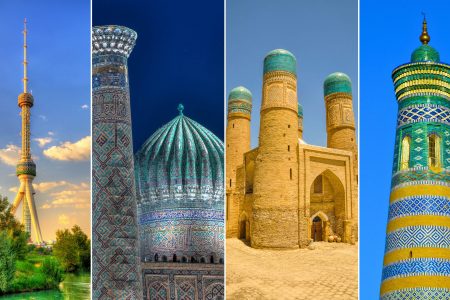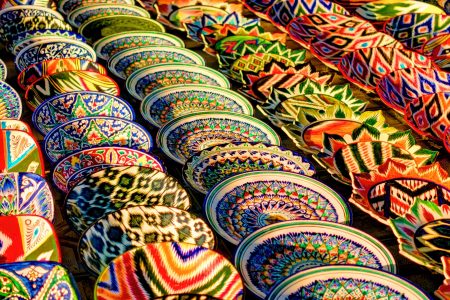With its unique architecture, interesting history as well as friendly people of Bukhara attracts tourists from all over the globe. Holy Bukhara is one of the most important and touristic cities of Uzbekistan. The historic city center was introduced in the UNESCO World Heritage List in (1993) and the age of the city is more than 2,500 years old, with hundreds of ancient landmarks and monuments.
In Cina nel V secolo la città di Bukhara si chiamava Nyumi, poi nelle fonti dell’Impero Tang fu chiamata An, Ansi, Buho e Buhe. Tuttavia, nelle fonti storiche viene spesso chiamata Bukhara. According to etymologists, the name is derived from the Sogdian word “buharak” and translates as “happy place”. Bukhara is also called the city of poetry and fairy tales, because the whole old city is famous for legends and stories.
Bukhara, con la sua ricca storia di quasi tremila anni, è stata una delle città che ha dato un contributo inestimabile alla civiltà mondiale. Nell’antichità, la definizione della città di Bukhara si è diffusa in tutto il mondo, grazie al progresso della scienza, dell’illuminismo e della cultura. La posizione di Bukhara al crocevia della Grande Via della Seta ha stimolato fin dai tempi più antichi lo sviluppo dell’artigianato e del commercio.
The city of Bukhara has been changed its status as the capital or the second most important city during the reigns of different rulers, it was famous not only for its mosques and madrassas, mausoleums, well-known scholars of the globe and prominent figures of the Islamic world, but also for its palaces, luxury houses, caravanserais, baths as well as commercial indoor bazaars with many domes. Preserved indoor bazaars at the crossroads of the city – it was built in the neighborhoods of the old city and performed different functions in the form of indoor bazaars were exactly the same described in the oriental fairy tales and movies we love to read and watch from our childhood, which make a great impression on us.
In the middle Ages, Bukhara was considered the holy and glory city of all Muslims in the Central Asia, where the most famous people gathered. Well-known Imam Al-Bukhari (9th century) was born, grew up, performed his Islamic knowledge and passed away in the territory of current Uzbekistan. He was an author of Al-Jame ‘al-Sahih, the second most important religious book in Islam after holly Qur’an.
On top of that Abu Ali ibn Sino (10th-11th centuries), was born in a small village in Bukhara region, performed numerous scientific researches and wrote numerous guide books dedicated to medicine in his lifetime in Bukhara and in other famous Muslim cities. It is vital to mention that he was well-known medical scholar, not only in Muslim world, but also in the world of medicine as Avisenna.
One of the holiest figures in Islam, the founder of Naqshbandi sect is Sheikh Bahauddin Naqshband (14th century), it is famous around the world as a major figure and leader of Sufism. Nel mondo islamico, il pellegrinaggio al mausoleo di Bahauddin Naqshband era equiparato al pellegrinaggio alla Mecca. Il mausoleo di Bahauddin Naqshband è tuttora considerato il luogo più sacro del mondo ed è visitato da migliaia di pellegrini e turisti provenienti da tutto il mondo. Bukhara is in the first place in terms of the number of historical monuments in Uzbekistan, and the ancient city can be observed by walking through the old city of Bukhara.
For the contribution of Muslim scholars, philosophers, architects and poets, the city has been awarded with the honorary titles of “The peak of Islam”, “Bukhara Sharif”, “Holy City”. In the middle Ages, seven cities around the world were given the title of Sharif because of their reputation as religious centers * (Mecca, Medina, Mazar-i-Sharif, Baghdad, Jerusalem, Damascus, and Bukhara-i- Sharif). One of them is Bukhara-i-Sharif (a holy Bukhara city of high reverence), which is one of the most common names of ancient Bukhara. Bukhara è stata chiamata con nomi diversi fin dall’antichità. La città ha anche svolto un ruolo importante nella promozione dell’Islam e del processo decisionale. Due to the fact that Bukhara has become one of the strongest centers of Islam in the East, because of Muslim morality, culture and jurisprudence, it was given the title of “Qubbat ul-Islam” – “Dome of Islam” in the early 9th century. Attualmente, Bukhara è una delle città più visitate dell’Uzbekistan e si sta sviluppando rapidamente nel campo del turismo.
Allo stesso tempo, la città è un centro di industria e cultura moderna. L’economia principale della regione di Bukhara è costituita dall’agricoltura (cotone, bachi da seta, meloni, verdure, cereali, orti e fattorie). L’allevamento è un’industria sviluppata nella regione di Bukhara, che comprende bovini, ovini, caprini, cavalli, cammelli e pollame. In particolare, la lana di pecora Karakul di Bukhara è apprezzata in tutto il mondo per la sua alta qualità e le forniture di lana Karakul vengono esportate in più Paesi.



